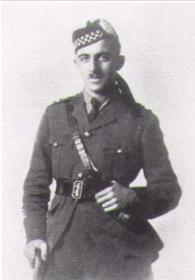David Lowe MacIntyre facts for kids
Quick facts for kids
David Lowe Macintyre
VC CB
|
|
|---|---|
 |
|
| Born | 18 June 1895 Portnahaven, Islay, Argyll |
| Died | 31 July 1967 (aged 72) Edinburgh, Scotland |
| Allegiance | |
| Service/ |
|
| Rank | Captain |
| Unit | Argyll and Sutherland Highlanders |
| Battles/wars | World War I |
| Awards | Order of the Bath |
| Other work | Under Secretary for Scotland, Ministry of Works |
David Lowe Macintyre was a very brave Scottish soldier. He was born on June 18, 1895. He won the Victoria Cross (VC). This is the highest award for courage. It is given to soldiers in the British and Commonwealth forces. He also received the Order of the Bath (CB). He passed away on July 31, 1967, when he was 72 years old.
Contents
A Hero in World War I
David Lowe Macintyre was 23 years old. He was a temporary lieutenant in the Argyll and Sutherland Highlanders. This was a famous Scottish regiment. He fought in World War I. His brave actions happened in France in August 1918. He was helping his battalion near Hénin and Fontaine-lès-Croisilles.
Courage Under Fire
Lieutenant Macintyre was the battalion's adjutant. This means he helped the commanding officer. He was always at the front lines. He stayed calm even when there was heavy shelling. Enemy machine guns were firing too. His calmness made everyone else feel confident.
Breaking Through Barbed Wire
At one point, his soldiers faced very strong barbed wire fences. These fences were put there by the enemy. Lieutenant Macintyre quickly organized a group of men. He led them forward under heavy fire. He personally watched as they made gaps in the wire. This allowed his unit to move ahead.
Facing a Machine Gun Alone
Later, he was no longer in charge of the front line. An enemy machine gun started firing very close to him. Without thinking, he rushed towards it all by himself. He made the enemy soldiers run away. Then, he brought the machine gun back.
Capturing a "Pill-Box"
Three days later, he was leading the front line again. He showed great courage. He also showed smart leadership. He found more barbed wire and checked it himself. He then led his men forward. When most of his unit was stopped, Lieutenant Macintyre gathered a small group. They pushed through enemy fire. They chased an enemy machine gun team. They found them hiding in a "pill-box." A "pill-box" was a small, strong concrete shelter. He and his group killed three enemy soldiers. They captured an officer and ten other soldiers. They also took five machine guns. Inside this area, they raided three more "pill-boxes." They dealt with the enemies inside. This helped his battalion capture the entire area.
Inspiring Leadership
After the battalion was told to defend their new position, Lieutenant Macintyre checked their right side. This side was open to enemy attack. While doing this, an enemy machine gun fired near him. He rushed it alone, making the team flee. He brought the gun back. He kept showing amazing spirit. He helped make sure the new position was secure. The success of the advance was largely because of Lieutenant Macintyre's great leadership. His bravery was an inspiration to everyone.
After the War
After World War I, David Macintyre worked for the government. He joined the Civil Service. He worked in the Office of Works. This office helped manage public buildings. He later became the Under Secretary for Scotland in the Ministry of Works. He was given another award, the Companion of the Order of the Bath (CB), in 1949. He retired from his job in 1959.
Where to See His Medal
Today, David Lowe Macintyre's Victoria Cross medal is on display. You can see it at the National War Museum of Scotland. This museum is located inside Edinburgh Castle in Scotland.

